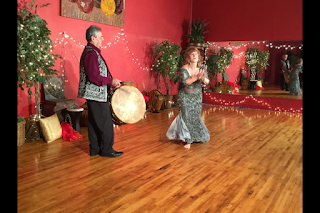FACE THE MUSIC
FACE THE MUSIC
As s instructors we have to help students to hear, understand and show the music when dancing. What does that all mean? Not all dancers are musically inclined. Some dancers even have trouble keeping or even hearing the beat. They need basic training in the music. Most of us did not grow up with an education in Arabic music and dance so we all have to learn. Without a basic understanding of the music those dancers will never understand the what and why of their dancing. But, they can can develop musicality. There are strategies to help students find the beat, recognize the rhythms, and better reflect their dancing.
Teach them how to count the music and where the accents are. This is a basic understanding. Most Arabic music at a student level is counted in 8s. Learn to recognize what a beledi, masmoudi etc rhythms are. There is only so many rhythms we use to dance. Start at the beginning. Always make sure your movements are centered. Always step on the down beat of 1. Using different music in class will help keep students engaged so they do not zone out.
Bring a drummer in. Let them hear the music live. Live music vibrates differently in the body than recorded music. Canned music is predictable as it is always the same but a live musician helps produce the right response to the muscles. As a beginner it is always the rhythm that students have to hook onto. Have students listen and stamp to the music with one foot or clap. I usually start with just one count like #1.
Always count 5,6,7, 8 before going across the floor. Then they know that is a down beat. I also use straight 4/4 music of different speeds. Then I have them practice a short combination. I never teach just steps after an 6 week Intro class. They need to think in terms of music not steps. Make a combination , then count it. They need to understand where the down beat is and that it is stronger than the other beats. If you do not explain it they do not understand it. Listen to the music, it tells you what to do. Learn how to play the derbecki.
Once all this has settled in, the dancer then needs to move into the melody and instrumentation. The melody gives you the feeling. But the instrumentation tells you which part of the body to move and . One simple step can be done in a hundred different ways to evoke the feeling needed. Finally there is staging. Most club dancers do not think of staging as they just play to the audience. But, any other types of setting you need it.
You need to make patterns on the floor for a reason. Otherwise it all becomes mundane. Choreograph a theater piece and you will see what I mean. There has to be a reason in why you are going where you do. You need advanced training. Not just average training. When you choreograph you have to listen to the music. Do a viral show on camera and then critique it. Or better still have someone else, in the know, do it. You cannot just stare at the camera. That is like dancing for 1.
So get with the program. Do your students and yourself a favor. Learn about Arabic music.
Morwenna Assaf = Author, Choreographer & Educator
Walid
Assaf = Percussionist, & Educator
https://ArtDanceAcademy.Webs.com
Art/Dance
Academy, USA 760-715-2276 ArabiDanseAcademie@sbcglobal.net

Comments
Post a Comment